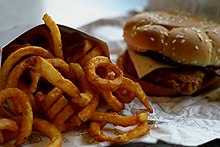西洋型食生活
西洋型食生活(英:Western pattern diet)、西欧型食生活は、赤肉、加工肉、バター、高脂肪の乳製品、卵、精製穀物、ジャガイモ、糖分の多いソフトドリンクを特徴とした近代の食習慣である[1]。 一方、健康的な食事には野菜果物が豊富で、全粒穀物、家禽(鳥)、魚が見いだされる[2][3]。 近代の西洋型食生活は、1万1千年前の新石器時代に農業革命があり、そしてそのずっと後の中世に産業革命がおこったことに続く根本的な生活様式の変化によってもたらされているが、人間の遺伝子の進化の尺度から見ればこの食事環境の変化には適応していない[4]。

要素 編集
この食習慣は、乳製品、加工されたり人工的に糖分が添加された食品、塩が多く、野菜果物、魚豆、全粒穀物が少ない[5]。様々な食品と食品加工手段が新石器時代と産業革命によってもたらされ、ヒトの祖先の食習慣の7種類の栄養特性を根本的に変えた。それは、血糖負荷、脂肪酸組成、主要栄養素の構成、微量栄養素の欠乏、酸塩基平衡、ナトリウム・カリウム比、食物繊維の量である[6]。19世紀の機械化は、高度に精製された穀物を広範に消費させることになった[6]。
産業革命と蒸気機関は、それまでの牧草を餌とする牛に代わって、19世紀後半にはトウモロコシという穀物によって育てられた肥満の牛を、効率的に人間の食料とするようになり、飽和脂肪酸の摂取量を増加させてきた[6]。
デンプンのような複合炭水化物は健康的だが、砂糖は標準的なアメリカの食事では頻繁に消費されその栄養品質はしばしば貧弱である[7][8]。1970年から2008年の間に、全食品からの消費カロリーは25%増加し、全体の10%は異性化糖(果糖ブドウ糖液糖)のコーンシロップであった[9]。砂糖および異性化糖は、産業革命以前には起こりえなかった量を消費させている[6]。穀物の精白技術の開発は微量栄養素を減少させ、精製糖には基本的にビタミンやミネラルなどの微量栄養素が含まれず、そうして微量栄養素の密度を低下させてきた[6]。
20世紀初頭から世紀末にかけて植物油の消費量は著しく増加した[6]。マーガリンとショートニングは1897年に開発された技術によって製造されている[6]。ω-6、ω-3のバランスの悪い多くの植物油は、n-6脂肪酸の比率を高めバランスを悪化させてきた[6]。飽和脂肪酸がバターに含まれている懸念から、マーガリンに変わりはじめ、1958年にはバターよりも消費されるようになった[10]。しかし、マーガリンには自然に存在しないトランス脂肪酸が生成されており[11]、心血管疾患に結びついている[12]。2005年には、トランス脂肪酸のそのリスクのため、今度はバターの消費が上回った[10]。しかし、飽和脂肪酸とトランス脂肪酸は共に心血管疾患に関連している[13][14]。
2004年のアメリカ合衆国の食生活のレビューは、外食の75%がファーストフードであり、メニューの半分はハンバーガー、フライドポテトかチキンであり、3分の1が炭酸飲料であった[15]。
関連項目 編集
出典 編集
- ^ Halton, Thomas L; Willett, Walter C; Liu, Simin; Manson, JoAnn E; Stampfer, Meir J; Hu, Frank B (2006). “Potato and french fry consumption and risk of type 2 diabetes in women”. The American Journal of Clinical Nutrition 83 (2): 284–90. PMID 16469985.
- ^ Hu, Frank B (February 2002). “Dietary pattern analysis: a new direction in nutritional epidemiology”. Curr Opin Lipidol 13 (1): 3–9. PMID 11790957.
- ^ Fung, Teresa T; Rimm, Eric B; Spiegelman, Donna; Rifai, Nader; Tofler, Geoffrey H; Willett, Walter C; Hu, Frank B (2001-01-01). “Association between dietary patterns and plasma biomarkers of obesity and cardiovascular disease risk”. The American Journal of Clinical Nutrition 73 (1): 61–7. PMID 11124751.
- ^ Carrera-Bastos, Pedro; Fontes; O'Keefe; Lindeberg; Cordain (March 2011). “The western diet and lifestyle and diseases of civilization”. Research Reports in Clinical Cardiology: 15. doi:10.2147/RRCC.S16919.
- ^ Bloomfield, HE; Kane, R; Koeller, E; Greer, N; MacDonald, R; Wilt, T (November 2015). “Benefits and Harms of the Mediterranean Diet Compared to Other Diets”. VA Evidence-based Synthesis Program Reports.. PMID 27559560.
- ^ a b c d e f g h Cordain, L; Eaton, SB; Sebastian, A; Mann, N; Lindeberg, S; Watkins, BA; O'Keefe, JH; Brand-Miller, J (February 2005). “Origins and evolution of the Western diet: health implications for the 21st century.”. The American journal of clinical nutrition 81 (2): 341–54. PMID 15699220.
- ^ Gary Taubes, Is Sugar Toxic?, The New York Times, April 13, 2011
- ^ Murtagh-Mark, Carol M.; Reiser, Karen M.; Harris, Robert; McDonald, Roger B. (1995). “Source of Dietary Carbohydrate Affects Life Span of Fischer 344 Rats Independent of Caloric Restriction”. The Journals of Gerontology Series A: Biological Sciences and Medical Sciences 50A (3): B148–54. doi:10.1093/gerona/50A.3.B148. PMID 7743394.
- ^ Philpott, Tom (2011年4月5日). “The American diet in one chart, with lots of fats and sugars”. Industrial Agriculture. Grist. 2011年12月1日閲覧。
- ^ a b “USDA ERS - Butter and Margarine Availability Over the Last Century” (英語). www.ers.usda.gov. 2017年8月9日閲覧。
- ^ Cordain, Loren; Eaton, S. Boyd; Sebastian, Anthony; Mann, Neil; Lindeberg, Staffan; Watkins, Bruce A.; O'Keefe, James H.; Brand-Miller, Janette (February 2005). “Origins and evolution of the Western diet: health implications for the 21st century”. The American Journal of Clinical Nutrition 81 (2): 341–354. ISSN 0002-9165. PMID 15699220.
- ^ Iqbal, Mohammad Perwaiz (2014). “Trans fatty acids – A risk factor for cardiovascular disease”. Pakistan Journal of Medical Sciences 30 (1): 194–197. doi:10.12669/pjms.301.4525. ISSN 1682-024X. PMC 3955571. PMID 24639860.
- ^ Ronald P. Mensink (2016). Effects of saturated fatty acids on serum lipids and lipoproteins: a systematic review and regression analysis. Whorld Health Organizatoin. ISBN 978-92-4-156534-9
- ^ Ronald P. Mensink (2016). Effect of trans-fatty acid intake on blood lipids and lipoproteins: a systematic review and meta-regression analysis. Whorld Health Organizatoin. ISBN 978-92-4-151060-8
- ^ Lobb, Annelena (2005年9月17日). “Eating Habits -- A Look At the Average U.S. Diet”. The Wall Street Journal 2011年12月1日閲覧。